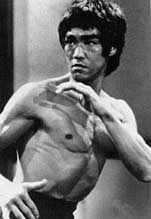Viewpoint
What didn’t Bruce Lee understand?
By Herb Borkland

This world-famous former Hong Kong street-fighter complained long and loud that traditional kung-fu wasn’t straight-forward enough, not truly centered on efficient fighting, but, instead, had gotten clogged up with “flowery” motions and useless repetitions. What didn’t Bruce Lee understand?
Who am I to say? But let’s be logical. Bruce Lee was an ego bastard. Knowing him as we do, isn’t it easily believable he was psychologically and philosophically out of tune with any possibility that what seemed “flowery” might actually be useful information expressed in an equally important but completely different register from his beloved fighting techniques?
Martial arts styles are the systematizing of information first danced ecstatically around a blood-smeared tribe’s victory bonfire. To the teenaged Cha-Cha-Cha Champion of Hong Kong, profound pre- or post-fight meditations being expressed in medieval Asian motions might seem merely dancerly. Three mincing but very precise dance steps defined The Cha-Cha-Cha; there was nothing flowing or flowery about it
Or very chi-full, either. Perhaps Bruce misunderstood certain little-known sequences he stumbled on, tangled up in there among the mishmashed motions of centuries, sequences which were in fact sophisticated chi drills. He could have very well overlooked their internal logic. Chi is not a young man’s study, by-and-large, and so this would also help explain their hated repetitiousness, since chi-circulating health-and-wellness exercises often have optimum numbers of repetitions needed for best results – usually, multiples of seven.
Bruce Lee… stripped to the waist, arms spread out like wings, his hands just-so, striking a signature fighting stance which, whatever else it is, is cocky as hell. This image remains the nearest Chinese martial arts have come in centuries to adding a new icon to join Bodhidharma and General Quan and whoever was the school’s founder there on their incense-dressed sun toi altars set up inside traditional kwoons.
This splendid public athleticism came graced, as well, by the traditional spiritual insightsappropriate to Shaolin-lineage kung-fu masters. Lee was also without doubt a studious man, a bright man, a lifelong autodidact and expert on the global library of books about man-to-man fighting.
His doodle-illustrated personal scrapbooks became the core of “Tao of Bruce Lee”, the single most widely read martial arts manual on Earth. But people come to it expecting a coherent system when what they find is a collection of quotes and jottings; the energy of the book, of Bruce’s mind, is not a vortex to suck you in but a centrifuge to spin you away.
The same problem of falling into pieces (of wing chun, escrima, taekwondo, fencing, western boxing, etc.) rather than generating synergy also haunts jeet kune do, the fighting style he founded. What became lucid and even inevitable when Bruce Lee the actor performed up on the screen, in real life decomposes into separate motions with no natural association outside of the context of Bruce Lee’s living body.
Jeet Kune Do is a generation old. Imagine a three-hundred year old style called No Kan Do. It would be a very old school, but, even so, like Jeet Kune Do, most of its signature techniques must predate the school’s founding. Or else how could the founding grandmaster have known them? No-way did he personally invent all of his style’s techniques.
Like Bruce did, the No Kan Do grandmaster discovered in real fights the saving grace of certain tried-and-true techniques when combined together thusly. That’s what was new – the thusly. It is some higher coherence and greater utility to these attack-defense combinations – the way they keep winning fights – not any claim of novelty for the moves themselves, which defines the style as a style, as being new, and the new style as being a school.
Jeet Kun Do is a style, okay, but not, unfortunately, a school.
In general, it can fairly be said, the best and worst things that have ever happened to kung-fu occurred because of Bruce Lee’s physical genius.
Against him it can be said: Bruce Lee popularized breaking the oldest unbroken chain of human learning – millennia-old martial arts instruction – by walking away from the traditional one-life one-style dedication which once had referred to its students as disciples. And yet to say so is not to say he did wrong.
Updating and amplification – this is what each new generation of students is expected to do. Champion-minded Bruce, child of an internationalist age, naturally set about combing the planet for fighting techniques unknown to kung-fu. Indeed, he may have been the first serious Chinese martial artist in history physically and by education able to assemble a complete library from around the world.
In American popular culture, Bruce Lee became the first Chinese man who didn’t do your wash, he ate your lunch. And his stature as a world-historical figure rests on being the artist whose work first revealed to a stunned Western audience that the martial arts are indeed really arts because they are beautiful.
About The Author:
Washington, D.C. native Herb Borkland has been called "a
martial arts pioneer" because he was an original student at the first
taekwondo school in the United States. After taking his degree at The
University of Virginia, Herb went on to become a closed-door student of
the legendary Robert W. Smith, author of the first English-language book
about tai chi. An Inside Kung-Fu Hall of Fame writer, he was the first
journalist ever invited to train in SCARS, the Navy SEALs fighting system.
Herb scripted "Honor&Glory" for Cynthia Rothrock, featured
on HBO, as well as winning the first-place Gold Award at the Houston International
Film Festival for his Medal of Honor soldier screenplay "God of War."
For three years he hosted the national half-hour Black Belts cable-TV
show. Herb and his wife, the Cuban-American painter Elena Maza, live in
Columbia, Maryland. He is also a regular columnist for FightingArts.com.
|